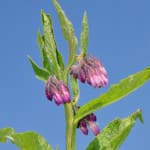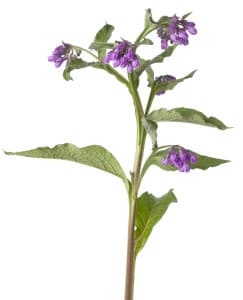What is comfrey?
What is comfrey and why should every homestead and gardener grow it?
In my opinion, comfrey is a miracle plant. It is easy to grow, lives for decades, makes some of the best plant-based fertilizer known to man, has been traditionally used to heal wounds and broken bones, mines hard to get minerals, creates heaps of organic material, and the list goes on and on. If there was ever a plant that does it all, comfrey is it.
Comfrey will grow in all kinds of conditions. It grows best in USDA zones 3-9 but can be grown successfully almost anywhere. It can survive temperatures down to -40º F and grows great in Africa in 120º F heat. This is a survivor plant for sure.
Is Comfrey Invasive?
That depends on who you talk to, what your definition of invasive is, and what variety of comfrey you have. Comfrey is a fast-growing perennial that is hard to kill. It reproduces amazingly from root cuttings so digging it up isn’t really an option if you want to get rid of it because the tiniest root will come back as a plant.
Wild comfrey (Symphytum Officianale) will reproduce from seed. Most other common varieties of comfrey are sterile and will not due to hybridization. Although most comfrey hybrids are sterile, they can still get out of hand, so don’t put a comfrey plant somewhere unless you want it there for a long time. Like forever.
As far as I’m concerned, what makes comfrey “invasive” makes it amazing! Comfrey will grow where other plants won’t and it gives back in a big way. It’s a plant that I want growing everywhere on my property. I’ve currently got it planted under fruit trees to be used as chop-n-drop nutrients and along my driveway to help reduce erosion, increase organic matter, and bring in pollinators.
[notification type=”alert-success” close=”false” ]Did you know that comfrey is the only land plant known to derive and store Vitamin B-12 from the soil![/notification]
How Does Comfrey Help My Garden?
The deep taproot on comfrey (grows 8 to 10 feet deep) allows it to dig into the soil and draw up nutrients that other plants can’t. Many of these nutrients end up in the large comfrey leaves. This makes it an excellent plant for chop-n-drop, compost, fodder, Liquid Fertilizer, and mulch.
As a dynamic accumulator, comfrey leaves break down quickly releasing the accumulated nutrients back into the soil in a form that other plants can take up. Putting it simply, adding comfrey to your garden soil will increase the nutritional density of your fruits and vegetables.
Is Comfrey Safe To Use Medicinally?
In light of all the great benefits of comfrey, it has been maliciously attacked by the FDA and FTC in recent years. For thousands of years, comfrey has been used as a part of the human diet with no record of anyone falling over dead from its use. It is true that studies have been done where rats received liver damage from being injected with concentrated pyrrolizidine alkaloids (PA) that are found in comfrey.
Let’s put the study in perspective. In order to consume the same amount of PAs as given in the study, one would have to eat 66,000 leaves in one sitting for 10 days (more than the person’s body weight) or over 800 leaves per day for 3 weeks. Since this is clearly a ridiculous study, it’s hard to take its claims seriously.
Here’s what the FDA said about the studies on their website just after explaining how dangerous it is.
“However, while information is generally lacking to establish a cause-effect relationship between comfrey ingestion and observed adverse effects humans, the adverse effects that have been seen are entirely consistent with the known effects of comfrey ingestion that have been described in the scientific literature.”
Can I Eat Comfrey?
While I believe that the safety police have gone way overboard on comfrey, there ARE real dangers to the PAs found in the plant. Making comfrey a large part of your daily diet would be foolish. With that said, many people eat a limited amount of comfrey and have no adverse effects. Due to the FDA’s findings, you will not find any commercially prepared comfrey for ingestion, as this would be illegal in the US. I cannot recommend that you take comfrey internally, but even if you leave that part out, comfrey offers so many benefits that its hard to see why it’s not in every yard, garden, and food forest.
Due to the FDA’s findings, you will not find any commercially prepared comfrey for ingestion, as this would be illegal in the US. I cannot recommend that you take comfrey internally, but even if you leave that part out, comfrey offers so many benefits that its hard to see why it’s not in every yard, garden, and food forest.
Shop online at Coe’s Comfrey.
So What Is Comfrey In A Nutshell?
Comfrey is one of the most versatile and beneficial plants you can grow. If you’re interested in propagating your own comfrey from root cuttings, check out the video below along with my post: Save Money Propagating Comfrey Cuttings. In addition, check out our article on building a raised comfrey bed.
Recent Posts
Spring 2025 Signature Solar Discount Code – 5% OFF EG4 6000XP Inverter (Limited Time!)
Looking for a Signature Solar discount code that works in 2025? Want to to save money on your next solar inverter purchase? You’re...
Parallel EG4 6000XP Install with EG4 WallMount Batteries
Welcome to the Ultimate DIY Off-Grid Solar Build For Beginners! If you’re planning an EG4 6000XP Install, this step-by-step guide will walk you...
How to Fix EG4 LifePower4 SOC Drift
Lithium SOC Drift Happens State of Charge (SOC) drift is a common issue you might face with your EG4 LifePower4 batteries. Over time,...






Comfrey is not the only plant to store B12. Geez get your facts. As for invasive, I don’t care I like it, thanks for adding to the problem
Author
Hey Andra, thanks for commenting. I’d love to hear from you what land plants, other than comfrey, store B12. It sounds like you’ve done some extensive research into the topic. Please share so we can all benefit from your knowledge and I’ll update the blog post.
Yeah, Andra, please share. Put your words and knowledge where your mouth is………..
Not a scholarly source by any means, but I find it interesting that even a vegan website says that NO plant can make OR STORE vitamin B12…not even comfrey:
http://www.veganhealth.org/b12/plant
From the horticulture department at Purdue University: “Comfrey produces large amounts of foliage from late May until hard frosts in October or November. This crop has been used as a salad green and potherb because it was considered a good source of protein and a rare plant-derived source of vitamin B12. Vitamin B12 is produced usually by soil bacteria and fungi or in the small intestines of some animals. Humans usually obtain this vitamin from eggs, dairy products, and meat. However, a study on the nutritional value of comfrey conducted in Australia in 1983 found that you would need to eat more than 4 lb/day of fresh comfrey to obtain the minimum daily requirement of B12. Eating such large amounts of comfrey, a poor source of vitamin B12, is inadvisable due to the potential health hazards.”
source: https://www.hort.purdue.edu/newcrop/afcm/comfrey.html
The argument of other plants storing B12 seems pointless to me.
Author
Thanks for sharing Sam. Just for the record (not that you’re disputing this), I never claimed that Comfrey was a great source of vitamin B12. I only stated that comfrey is the only land plant known to derive and store Vitamin B12 from the soil. I find that interesting and thought others might as well. And I must say, If you’re not getting B12 from any other source due to suppressing your diet, It would be an asset.
Thank you for this well written and researched account of comfrey and its many benefits. I like to plant comfrey underneath fruit trees because the deep tap roots of the comfrey plant occupy a different soil strata than the shallower roots of most fruit trees. This was indirectly inferred in your post but I thought it worth repeating. Comfrey also outcompetes lawn, which would otherwise compete with the trees.
Author
That’s a great point Bobby. One thing to keep in mind is that comfrey gets big real fast. Be sure that the fruit tree is somewhat established before planting the comfrey next to it. As an example of what not to do: I placed a small mulberry tree seedling (about 4 inches tall) and didn’t realize that the year before I planted a comfrey cutting in that same spot. The comfrey has overtaken the area and is threatening the mulberry. I will be digging up the mulberry to plant it somewhere else because the comfrey will always come back if I try to dig it up.
Just discovered this plant, can’t wait to start growing it! I am very interested in getting some cuttings.
Author
It’s pretty amazing! I’ll send you an email to get some info.
Thanks for a great blog & video! Sign me up as someone who’s interested in your “how to make fertilizer from Comfrey” video/blog.
Horses are critical to my homestead, so I always hope they will be explicitly mentioned when someone discusses a plant.
Since horses weren’t specifically mentioned, here’s what I learned about Comfrey WRT livestock in case it matters to anybody else:
Summary: comfrey isn’t a suitable staple crop for horses to graze, and feeding dried comfrey may increase risks of liver damage, but fresh comfrey leaves seem to be universally OK’d for external use, and multiple equine professionals and herbalists recommend adding comfrey to a horse’s feed to help heal almost any sort of injury.
1. Cornell is my go-to resource for equine plant toxicity, and this is the first article I’ve seen where they indicated uncertainty as to toxicity. (Summary: there have been mixed reviews about Comfrey’s toxicity, but fresh leaves have much smaller concentrations of the toxins, and sale of comfrey has been banned in Canada even though there are mixed opinions regarding its medicinal use):
https://ansci.cornell.edu/plants/medicinal/comf.html
2. Ellen Collinson endorses comfrey’s external application without reservation, endorses feeding it to horses for almost any injury, and mentions that feeding the roots to horses once annually is common practice amongst French Gypsies:
http://www.equineiridology.eu/herbs.php
3. In the comments for this Kim Wang blog about Comfrey, a reader mentions that she has used comfrey to allow several horses to recover who would otherwise have been put down. Her specific recommendation is 1/2 – 1 cup of fresh green leaves 3x daily for a fresh injury, reducing by half over time “until the injury is no more.” She also recommends making a comfrey tea and soaking a bandage in it to be used to wrap a wound.
http://www.naturalremedies.org/comfrey/
Author
That’s really great info on comfrey for horses! Thanks for letting us know.
Hey Eric, I will be in Tyler around Thanksgiving. Do you still have cuttings available? Laura
Author
Hey Laura, I can get some. Send me a direct message through our Facebook page and we can figure out a time and place to meet.
I want some.
Author
Elizabeth, somehow I missed this earlier. Sorry about that. Contact me through our Facebook page and I can get some to you.
I am desperately trying to find comfrey in my area. I live near Naples tx and would like to buy some from you. I will be willing to travel to your area and pick them up. Please give me directions or a phone number where I can reach you. I use the root for knee problems but the comfrey leaf is much better.
Author
Hi Dee, I will email you to see if we can work something out.
Thank you, I look forward to your email.
Dee harker, i will send you free comfrey roots from bonnie Scotland if you are willing to cover the postage to Naples tx?
Kind Regards Andy x.
Hi. I have property in Van Zandt county, and would love some comfrey cuttings, or seedlings, or seeds. I’m a beginner, so will take whatever you think is best. Just let me know how to access them.
Thanks for offering,
Kay Allen
Author
Hey Kay, I’d be happy to meet you in Tyler and give you a couple root cuttings. The variety of comfrey I have is sterile so it will not reproduce from seed.
If that’s something you’re interested in, let me know and I’ll send an email to the address you submitted the form with and we can setup a time to meet.
I would deeply appreciate a cutting! I am just learning about comfrey and want to give it a try. I live in Henderson County and could meet you in Tyler.
Pingback: Learn How to Make a Comfrey Poultice With a Blender « East Texas Homestead
hey there I am in east texas and would love some cuttings from anyone thanks
Author
Hey Jerry, I’ll email you to work something out. Thanks!
I’m in the Tyler area. Do you have any comfrey cuttings available?
Author
Hey Lauren, sorry to just get back to you. I’ve found that this isn’t the best time of year to plant it. Check back this fall and we will work something out.
Please do an article on how to find wild comfrey in Texas. Shalom
Author
That would be a great article! In full disclosure though, I’ve never found wild comfrey so I’m probably not the best resource there.